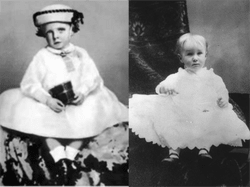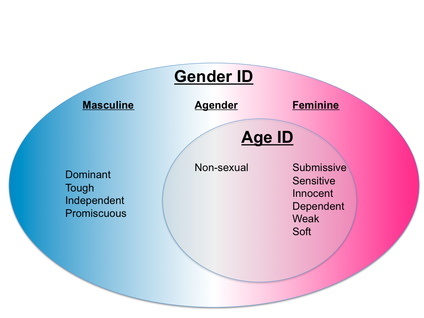What is Age?
Age is a concept that can be broken down into many meanings depending on the context.
Chronological age is the number of years someone has been alive. This is what most people think of when they are asked how old they are.
Chronological age is important because it tells us:
How many more years of life the person has left.
How likely the person is to have had certain experiences/ how much life experience* they have. (Remember 911? Vietnam?)
Reproductive capabilities.
May indicate certain physical limitations. (Can they Lift 50 lbs?)
Chronological age does not tell us:
How responsible we are. (Our criminal Justice System is full of “responsible adults”)
What activities we do or do not care for (Why would a 40 year old want to wear diapers and a onesie?)
Our libido or sexual orientation (Some people mistakenly believe that children are Asexual and that every 20 year old is a pile of pent up sexual urges)
Chronological age does not tell us much. Actually the majority of society's prescriptions about age are exactly that, social constructions in the same manner as those regarding gender. These social constructions are flat generalizations that fail to accurately describe our depth as individuals.
Many individuals in the Age non-conforming spectrum exist outside the mainstream expectations of age appropriate behavior. These individuals encounter difficulty justifying their behavior (wearing diapers, using pacifiers...etc.) to others, and the response in many cases, is to automatically attribute these behaviors to a fetish.
Many Age non-conformers however, do not attribute their behaviors to a fetish. Moreover some individuals have either by choice, or by their own inherent nature have completely “divorced” their little-space from their sexuality all-together. The community has grappled with the question “If it isn't a fetish, what is it?”. For a long time these individuals have described themselves as “lifestylers”. Now there is an increasing number of people are not satisfied identifying as men or women, but instead choosing labels such as “little boy/girl” to describe themselves.
The truth (for some at least):
For some in the age non-conforming spectrum, the motivations behind their behaviors are centered around a sense of self that is not congruent with their chronological age.
Everyone has an internal sense of who they are and how they feel about themselves. In addition to concepts of gender identity and sexual orientation there is also age identity.
What is age identity then....
Age identity is ones own subjective sense of their age*.
The “age*” can be further broken down into some of the following spectrum (not a complete list): Dependency v Independence, Sensitive v Cold, Innocent v “Bad”, Submissive v Dominant, Passive v Aggressive, Sexually Aggressive v Not Sexual....
In a nutshell, these traits form the backbone of our society's age (and gender) norms.
The thing that everyone should immediately notice is that these are more or less the traits associated with either being masculine or feminine. There is a significant overlap between age and gender identities. In fact it can be argued that age identity is a component of gender identity.
Aside: The author uses the term "Agender" and "little boy" interchangeably along with "they/thier" pronouns.
Chronological age is the number of years someone has been alive. This is what most people think of when they are asked how old they are.
Chronological age is important because it tells us:
How many more years of life the person has left.
How likely the person is to have had certain experiences/ how much life experience* they have. (Remember 911? Vietnam?)
Reproductive capabilities.
May indicate certain physical limitations. (Can they Lift 50 lbs?)
Chronological age does not tell us:
How responsible we are. (Our criminal Justice System is full of “responsible adults”)
What activities we do or do not care for (Why would a 40 year old want to wear diapers and a onesie?)
Our libido or sexual orientation (Some people mistakenly believe that children are Asexual and that every 20 year old is a pile of pent up sexual urges)
Chronological age does not tell us much. Actually the majority of society's prescriptions about age are exactly that, social constructions in the same manner as those regarding gender. These social constructions are flat generalizations that fail to accurately describe our depth as individuals.
Many individuals in the Age non-conforming spectrum exist outside the mainstream expectations of age appropriate behavior. These individuals encounter difficulty justifying their behavior (wearing diapers, using pacifiers...etc.) to others, and the response in many cases, is to automatically attribute these behaviors to a fetish.
Many Age non-conformers however, do not attribute their behaviors to a fetish. Moreover some individuals have either by choice, or by their own inherent nature have completely “divorced” their little-space from their sexuality all-together. The community has grappled with the question “If it isn't a fetish, what is it?”. For a long time these individuals have described themselves as “lifestylers”. Now there is an increasing number of people are not satisfied identifying as men or women, but instead choosing labels such as “little boy/girl” to describe themselves.
The truth (for some at least):
For some in the age non-conforming spectrum, the motivations behind their behaviors are centered around a sense of self that is not congruent with their chronological age.
Everyone has an internal sense of who they are and how they feel about themselves. In addition to concepts of gender identity and sexual orientation there is also age identity.
What is age identity then....
Age identity is ones own subjective sense of their age*.
The “age*” can be further broken down into some of the following spectrum (not a complete list): Dependency v Independence, Sensitive v Cold, Innocent v “Bad”, Submissive v Dominant, Passive v Aggressive, Sexually Aggressive v Not Sexual....
In a nutshell, these traits form the backbone of our society's age (and gender) norms.
The thing that everyone should immediately notice is that these are more or less the traits associated with either being masculine or feminine. There is a significant overlap between age and gender identities. In fact it can be argued that age identity is a component of gender identity.
Aside: The author uses the term "Agender" and "little boy" interchangeably along with "they/thier" pronouns.
We know this....
Man ≠ Boy
Woman ≠ Girl
Gender Identity = Masculine/Feminine Component + Age Component + Potentially "Other Components"
Some Examples of "other components" of gender identity/expression include:
1. Time/Context Variant Fluctuations (Gender-fluid Folks)
2. Ethnic components (Fa'afafine – Gender Identity Exclusive to Certain Polynesian Subgroups)
3. Time Period (Men Used to Wear Makeup and Wigs)
Identities are multi-dimensional.
Look at the “Sissy” gender identity.
Sissy- Someone who usually/exclusively identifies as male, but role-plays/sometimes identifies as baby girl (often coupled with a desire for reduction in power).
Sissy= Masculine Component (real) + Feminine Component (fantasy/temporary state) + Age Component (baby)
There are a lot of dimensions to this identity besides being on a scale from masculine to feminine. In fact boiling gender identity down to masculne/feminity can be problematic for agender and androgenous folks as well.
Man ≠ Boy
Woman ≠ Girl
Gender Identity = Masculine/Feminine Component + Age Component + Potentially "Other Components"
Some Examples of "other components" of gender identity/expression include:
1. Time/Context Variant Fluctuations (Gender-fluid Folks)
2. Ethnic components (Fa'afafine – Gender Identity Exclusive to Certain Polynesian Subgroups)
3. Time Period (Men Used to Wear Makeup and Wigs)
Identities are multi-dimensional.
Look at the “Sissy” gender identity.
Sissy- Someone who usually/exclusively identifies as male, but role-plays/sometimes identifies as baby girl (often coupled with a desire for reduction in power).
Sissy= Masculine Component (real) + Feminine Component (fantasy/temporary state) + Age Component (baby)
There are a lot of dimensions to this identity besides being on a scale from masculine to feminine. In fact boiling gender identity down to masculne/feminity can be problematic for agender and androgenous folks as well.

(Theodore roosevelt, and Franklin Theodore Roosevelt wearing dresses)
Some History
Age identity skews gender identity, and certainly gender expression to some degree. In general immaturity skews gender expression away from masculinity. Overall it is fairly difficult to separate age identity from gender identity because as we saw above, they share so many of the same "nuts and bolts". Children are given a lot more flexibility in regards to their gender expression. In fact the trend towards strongly gendered children's clothes was a recent one. Not so long ago there wasn't a Sear's catalog, you probably just used the same clothes from your last child (and hope this one wont die this winter).
Really, the major difference between age identity, and gender identity is that age identity is supposed to be time dependent (linearly) and that gender identity is expected to be static. There is a society expectation for people to “progress” through different age identities at different points in their lives. Many in the age non-conforming community have difficulty being able to live full authentic lives. Sadly, this fear is not surprising considering the general hostility towards gender non-conforming people as a whole...
Final Thoughts
Ultimately identity is an internal experience, however we are all bound by the context we find ourselves in. It is our context that gives us the labels we try to use to explain our identities to others. As a queer person the author has found from their perspective that the terminology used to describe gender identity are the most natural way of articulating their age identity.

